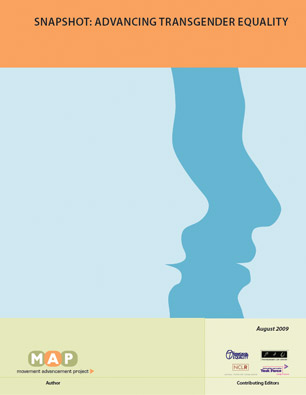The Bottom Line
The Advancing Transgender Equality Snapshot Report provides an overview of the movement for transgender equality, focusing on its evolution and growth over time. The report also looks at the obstacles that transgender Americans face in everyday life and the work under way to overcome those obstacles. It includes 10 key recommendations that can help make the work of lesbian, gay, bisexual and transgender (LGBT) organizations more transgender-inclusive and relevant, and additional recommendations intended to help funders increase their support for transgender equality..
Snapshot: Advancing Transgender EqualityDownload
Recommended citation:
Abstract
In recent years, the movement for transgender equality in the United States has achieved important gains. Organizations focused exclusively on transgender issues are adding full-time staff and increasing their budgets, while general LGBT groups are adding transgender-specific programs to their programmatic work. On the public policy front, increased resources combined with persistent advocacy in the last two decades have led to some significant advances, especially in providing increased protection from hate crimes and employment discrimination for transgender Americans. Meanwhile, increasing numbers of corporations have adopted transgender-inclusive nondiscrimination policies.
Despite this progress, many challenges persist. In 2008, for example, opponents of LGBT rights began to introduce anti-transgender measures as part of a broader campaign against LGBT equality. The transgender movement, while growing, still needs tactical, political and financial support to capitalize on current opportunities and defend against opponents’ attacks.
The Advancing Transgender Equality Snapshot Report is divided into five sections:
- The first provides a brief look at the evolution and growth of today's movement for transgender equality.
- The second examines the obstacles that face transgender Americans, including issues related to physical and mental health; safety and physical security; legal documentation and relationship rights; and employment and self-sufficiency.
- The third describes the work under way to overcome the obstacles outlined in the second section.
- The fourth section provides 10 key recommendations that general LGBT organizations should consider to make their work more transgender-inclusive and relevant.
- The final section provides five key recommendations to help funders increase their support for transgender equality.


